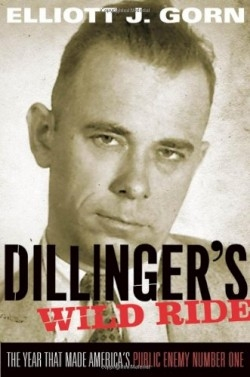Dillingers Wild Ride
The Year That Made America's Public Enemy Number One
Though John Dillinger’s story is a familiar one, Elliot J. Gorn seeks a less traditional route in its retelling. Using government documents and newspapers, Gorn describes the activities of the Dillinger gang during their final year and law enforcement efforts to stop them, giving particular emphasis to language and the public’s perception of the gangs psychological motivations:
At 10:20 p.m. on July 22, 1924, John Dillinger was gunned down by federal agents as he left Chicago’s Biograph theater. Thousands of people turned out on Lincoln Avenue where he fell, at the city morgue to view the body, at his grave in Indianapolis’s Crown Hill Cemetery For the next several days the newspaper headlines were filled with little else aside from Dillinger’s death. Someone scrawled a bit of doggerel on the Lincoln Avenue sidewalk:
“Stranger stop and wish me well,
Just say a prayer for my soul in hell,
I was a good fellow, most people said,
Betrayed by a woman, all dressed in red.“
This passage, more than any other, captures the story of John Dillinger; the public’s relationship with him is a driving force of the tale. The emotional resonance of Dillinger’s exploits, which occurred during the Great Depression, is not lost on us today, as we cope with a financial crisis often compared to the Great Depression. Then, as now, banks were failing and were perceived as Americas true Public Enemy Number One, despite the fact that Dillinger officially carried that title. He, on the other hand, seemed to both excite and horrify people with his daring prison breaks and all-out war against despised banking institutions and law enforcement. His charisma and coolness served to make the outlaw a notorious household name, which is recognized even today. Though Gorn’s version reads like an extensive news article, briefly touching on remarkable early years and on later notorious acts of violence, the subject is nonetheless an enthralling one. Those with a particular interest in true crime or biographies will find Gorns no-frills approach refreshing.
Elliot J. Gorn teaches at Brown University. He is the author of The Manly Art: Bare-Knuckle Prize Fighting in America and Mother Jones: The Most Dangerous Woman in America, among other books.
Reviewed by
Shewanda Pugh Garner
Disclosure: This article is not an endorsement, but a review. The publisher of this book provided free copies of the book to have their book reviewed by a professional reviewer. No fee was paid by the publisher for this review. Foreword Reviews only recommends books that we love. Foreword Magazine, Inc. is disclosing this in accordance with the Federal Trade Commission’s 16 CFR, Part 255.

